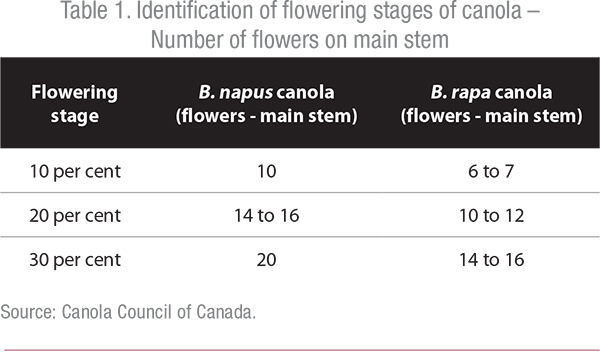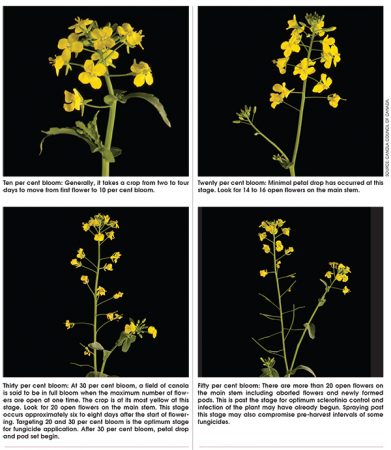
If you plan to use a fungicide for sclerotinia control, being able to assess the correct application stage is critical. Go too early and the disease may develop on petals that developed after the fungicide spray. Go too late and you may allow the disease to develop on early petal drop. Research has shown that 20 to 30 per cent blossom is the Goldilocks stage for fungicide application.
“It is important to get in with a fungicide at early flowering to protect the plant from sclerotinia infection. The petals are the primary food source, so covering the majority of the petals with a preventative fungicide spray application will help to prevent the disease from developing. Once you see the disease developing, it is too late to spray,” says Harold Brown, market development specialist with Bayer CropScience in Winnipeg. “Targeting that 20 to 30 per cent stage will usually give you the best fungicide response.”
When a blossom drops and lands on a leaf or stem, the sclerotinia spores use the spent blossom for food and produce the hyphae that grow and eventually penetrate the plant – unless that blossom has been treated with a fungicide. Generally, at 20 per cent blossom, no petals have dropped, while at 30 per cent blossom, petal drop has just begun.
“I encourage growers to get out and start scouting as soon as the crop starts to flower, so they can assess how uniform the field is, and to help keep close watch on how fast the crop is developing,” says Brown. “I usually get right in there and pull out plants so I can assess which flowers are on the main stem, and can better assess the flowering stage. It doesn’t take long to move from 10 per cent flower to 30 per cent flower, so you have to be ready to scout your fields.”
To target 20 to 30 per cent bloom, field scouting is critical, as blossoming can progress rapidly. Flowering is considered to have started with the opening of the lower bud on the main stem. Flowering continues upward on the main stem with three to five flowers opening per day. Depending on weather conditions, canola will move from first flower to 20 per cent bloom in three to six days. The challenge is to be able to assess when 20 to 30 per cent blossom happens.
The Canola Council of Canada has guidelines on determining bloom stage in canola (see Table 1). Sample several plants over the field and assess the number of open flowers. One way to check for bloom stage is to find the main stem, pull off the secondary branches, and count only the open flowers on the main stem.
Use the Canola Council of Canada’s Sclerotinia Stem Rot Checklist to assess your disease risk. And then it will be time to walk the walk. With a short time period (four to eight days from first flower to 20 to 30 per cent bloom), growers need to be scouting and prepared for a fungicide application if conditions for sclerotinia infection are favourable.

